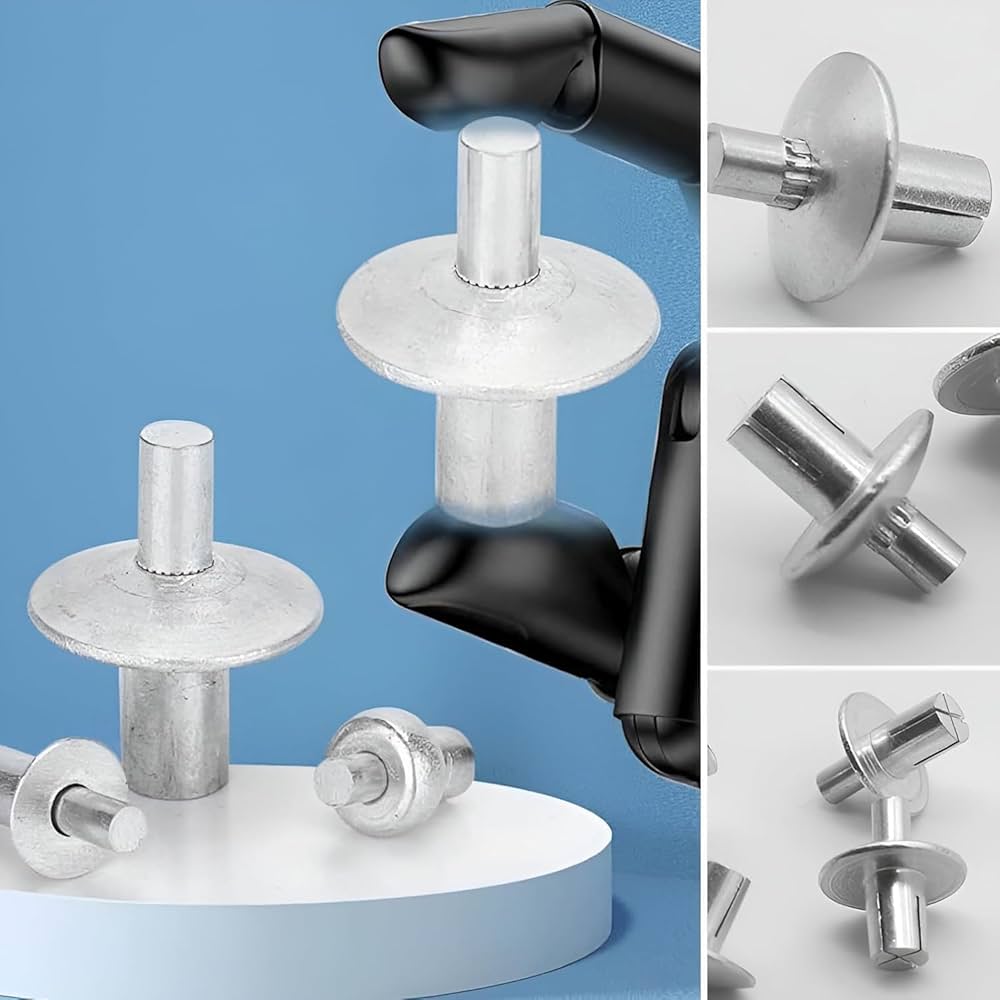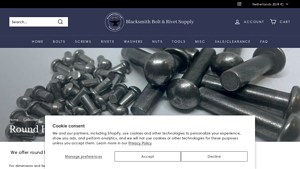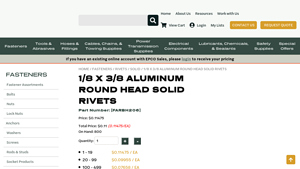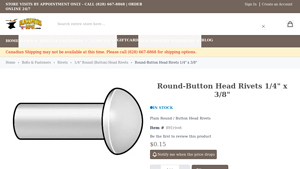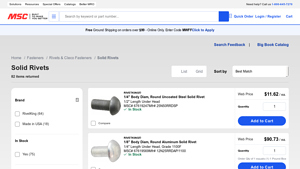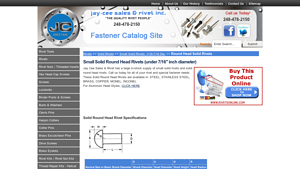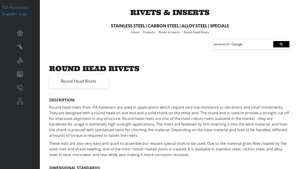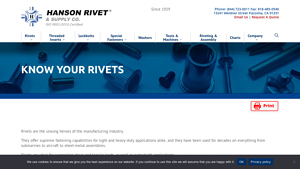Round Rivets Guide: Type, Cost, Top List…
Introduction: Navigating the Global Market for round rivets
Navigating the global market for round rivets can present significant challenges for B2B buyers, particularly in regions such as Africa, South America, the Middle East, and Europe. The complexity of sourcing high-quality round rivets that meet specific industry standards while balancing cost-effectiveness is a common hurdle. This guide aims to streamline the purchasing process by providing a comprehensive overview of various types of round rivets, including solid steel and aluminum options, and their diverse applications across industries such as construction, automotive, and manufacturing.
Buyers will benefit from detailed insights into supplier vetting processes, ensuring they select reliable partners who adhere to international standards. We will also explore critical factors influencing pricing, enabling informed budgeting and procurement decisions. With a focus on actionable strategies, this guide empowers international B2B buyers, particularly from markets like Nigeria and Brazil, to make well-informed choices that enhance operational efficiency and product quality. By understanding the nuances of round rivet specifications, applications, and sourcing strategies, buyers can navigate the complexities of the global market with confidence, ultimately leading to improved project outcomes and cost savings.
Understanding round rivets Types and Variations
| Type Name | Key Distinguishing Features | Primary B2B Applications | Brief Pros & Cons for Buyers |
|---|---|---|---|
| Solid Round Head Rivets | One-piece construction, round head design | Automotive, aerospace, construction | Pros: Strong, reliable joints; Cons: Requires special tools for installation. |
| Aluminum Round Head Rivets | Lightweight, corrosion-resistant, non-magnetic | Electronics, HVAC, general fabrication | Pros: Lightweight and resistant to corrosion; Cons: Less strength compared to steel. |
| Stainless Steel Round Rivets | High corrosion resistance, suitable for harsh environments | Marine, food processing, chemical handling | Pros: Excellent durability; Cons: Higher cost than other materials. |
| Copper Round Head Rivets | Good electrical conductivity, malleable | Electrical applications, plumbing | Pros: Ideal for electrical connections; Cons: Less strength than steel. |
| Countersunk Round Head Rivets | Flat head allows for flush finish | Furniture, cabinetry, structural work | Pros: Aesthetic finish; Cons: Requires precise installation for effectiveness. |
What Are Solid Round Head Rivets and Their Applications?
Solid round head rivets are characterized by their one-piece construction and a prominent round head that provides a larger bearing surface. They are widely used in high-strength applications such as automotive and aerospace manufacturing, where reliable joints are essential. When purchasing, consider the specific material requirements, as these rivets can be made from various materials including steel and aluminum. Buyers should also be aware that while these rivets offer exceptional strength, they typically require specialized tools for installation, which can add to overall costs.
How Do Aluminum Round Head Rivets Benefit Various Industries?
Aluminum round head rivets are known for their lightweight properties and resistance to corrosion, making them ideal for applications in the electronics and HVAC sectors. Their non-magnetic nature also adds to their versatility, particularly in sensitive electronic environments. When sourcing aluminum rivets, buyers should assess the strength requirements of their projects, as aluminum rivets may not provide the same tensile strength as their steel counterparts. However, their ease of installation and lower weight often make them a preferred choice in industries focused on efficiency and performance.
What Are the Advantages of Stainless Steel Round Rivets?
Stainless steel round rivets are highly regarded for their durability and resistance to corrosion, making them suitable for demanding environments such as marine and food processing applications. The ability to withstand harsh chemicals and conditions is a significant advantage for buyers in these sectors. While the initial cost may be higher compared to other materials, the long-term benefits of reduced maintenance and increased lifespan can justify the investment. Buyers should consider the specific grade of stainless steel required for their applications to ensure optimal performance.
In What Situations Should Copper Round Head Rivets Be Used?
Copper round head rivets are primarily utilized in electrical applications due to their excellent conductivity and malleability. They are often found in plumbing systems and electrical connections, where reliable conductivity is crucial. While they provide significant advantages in electrical contexts, buyers should note that copper rivets may not offer the same strength as steel rivets. When sourcing copper rivets, it’s essential to consider the specific electrical requirements and environmental conditions, as copper can corrode in certain environments without proper treatment.
Why Choose Countersunk Round Head Rivets for Aesthetic Applications?
Countersunk round head rivets feature a flat head that allows for a flush finish, making them particularly suitable for furniture and cabinetry applications where aesthetics are important. These rivets require precise installation to ensure that they sit flush with the surface, which can enhance the overall appearance of the final product. Buyers should be mindful of the installation requirements and potential for misalignment, which can compromise the effectiveness of the rivet. However, when installed correctly, they provide a clean and professional look that is often sought in high-end applications.
Key Industrial Applications of round rivets
| Industry/Sector | Specific Application of round rivets | Value/Benefit for the Business | Key Sourcing Considerations for this Application |
|---|---|---|---|
| Aerospace | Assembly of aircraft components | Ensures structural integrity and safety | Compliance with aviation standards and certifications |
| Automotive | Manufacturing of vehicle frames and body panels | Provides strong, durable connections | Material specifications for corrosion resistance |
| Construction | Joining structural steel beams and frameworks | Enhances load-bearing capabilities | Sourcing for high-strength materials |
| Marine | Fastening hull components and deck fittings | Resilience against harsh marine environments | Availability of marine-grade materials |
| Electrical & Electronics | Assembly of electronic enclosures and chassis | Facilitates reliable connections and grounding | Precision in dimensions for electronic applications |
How Are Round Rivets Used in Aerospace Applications?
In the aerospace industry, round rivets are crucial for assembling aircraft components such as wings, fuselages, and control surfaces. These rivets provide exceptional strength and durability, essential for withstanding the high-stress conditions encountered during flight. Buyers in this sector must ensure that their rivets meet stringent aviation standards and are certified for use in aircraft manufacturing, as any failure can lead to catastrophic consequences.
What Role Do Round Rivets Play in Automotive Manufacturing?
Round rivets are extensively used in the automotive industry for the assembly of vehicle frames and body panels. They provide robust and permanent fastening solutions that enhance the overall structural integrity of vehicles. For international buyers, especially from regions like Africa and South America, sourcing rivets that meet specific automotive standards is critical to ensure compliance and longevity in vehicle performance, particularly in challenging terrains.
Why Are Round Rivets Important in Construction?
In construction, round rivets are employed to join structural steel beams and frameworks, contributing to the stability and safety of buildings and bridges. Their ability to create strong connections allows for efficient load distribution, making them ideal for high-rise constructions. Buyers in this sector should prioritize sourcing high-strength materials that can withstand environmental factors, ensuring long-term durability and compliance with local building codes.
How Are Round Rivets Used in Marine Applications?
Marine industries rely on round rivets to fasten hull components and deck fittings, where resistance to corrosion and environmental wear is paramount. These rivets must be made from marine-grade materials to ensure longevity in saltwater conditions. For buyers in the Middle East and Europe, it is crucial to consider the specific environmental challenges and ensure that the rivets sourced have appropriate protective coatings or are made from corrosion-resistant alloys.
What Benefits Do Round Rivets Offer in Electrical & Electronics Assembly?
In the electrical and electronics sector, round rivets are used for assembling electronic enclosures and chassis, providing reliable connections and grounding. Their precision in dimensions is vital for ensuring proper fit and function within electronic devices. International buyers, particularly from Europe, should focus on sourcing rivets that meet industry standards for electrical safety and reliability, ensuring that their products perform effectively in various applications.
3 Common User Pain Points for ’round rivets’ & Their Solutions
Scenario 1: Ensuring Compatibility with Existing Materials
The Problem: A B2B buyer from the automotive industry is faced with the challenge of sourcing round rivets that will seamlessly integrate with various materials used in their production line. The buyer discovers that many suppliers offer rivets made from different materials such as steel, aluminum, and brass, but lacks clarity on which material will provide the best strength and corrosion resistance for their specific applications. The risk of selecting the wrong rivet could lead to product failures, increased costs, and significant delays in production.
The Solution: To overcome this challenge, it is essential for the buyer to conduct a thorough analysis of the materials involved in their assembly process. They should collaborate with engineers to understand the mechanical and environmental conditions that the rivets will face, including load requirements and exposure to elements like moisture or chemicals. Once this data is gathered, the buyer can request samples of round rivets from suppliers, specifying the exact material grades that meet their needs, such as stainless steel for corrosion resistance or high-strength aluminum for weight savings. Additionally, establishing a relationship with a supplier that offers custom solutions can provide access to rivets that are tailored to specific application requirements, ensuring compatibility and performance.
Scenario 2: Navigating Size and Specification Challenges
The Problem: A construction firm is tasked with a project requiring precise specifications for round rivets, but the available options seem overwhelming. The buyer struggles to determine the correct diameter and length of rivets needed to secure structural components effectively. Misjudgments in sizing can compromise the integrity of the construction, leading to safety hazards and costly rework.
The Solution: To navigate these sizing challenges, the buyer should utilize detailed drawings and specifications provided by their engineering team. It is beneficial to refer to industry standards such as DIN or ISO specifications for round rivets, which offer guidance on the appropriate dimensions and tolerances. Engaging with suppliers who can provide comprehensive technical support is crucial. The buyer should also consider investing in a prototyping phase where different sizes of rivets can be tested within the actual assembly to ensure the best fit and performance. Documenting the testing results can help in making informed decisions and creating a reference for future projects, minimizing the risk of sizing errors.
Scenario 3: Managing Lead Times and Supply Chain Issues
The Problem: An electronics manufacturer faces delays due to extended lead times from their current rivet suppliers. As production schedules tighten, the buyer is under pressure to find a reliable source of round rivets that can meet their urgent demands without compromising quality. The uncertainty in supply chain logistics further complicates their ability to maintain production flow.
The Solution: To manage lead times effectively, the buyer should prioritize building relationships with multiple suppliers across different regions. This diversification can mitigate risks associated with supply chain disruptions, especially for international buyers in Africa or South America, where logistics may be less predictable. Additionally, the buyer should consider negotiating blanket purchase orders with suppliers, which can secure a consistent supply of rivets while potentially lowering costs. Implementing a just-in-time inventory system can also optimize stock levels and reduce waste. Regular communication with suppliers about their production capabilities and lead times will enable the buyer to plan more effectively and adapt to any changes in the supply landscape, ensuring that they can meet their production deadlines.
Strategic Material Selection Guide for round rivets
What Are the Key Properties of Common Materials for Round Rivets?
When selecting materials for round rivets, it is essential to consider the specific properties that influence performance in various applications. The most common materials used for round rivets include steel, aluminum, stainless steel, and brass. Each material presents unique characteristics that can impact durability, cost, and suitability for specific environments.
How Does Steel Perform as a Material for Round Rivets?
Steel is widely used for round rivets due to its high tensile strength and durability. It can withstand significant pressure and is suitable for applications requiring robust fastening solutions. Steel rivets are typically rated for high-temperature environments, making them ideal for industries like automotive and construction.
Pros: Steel rivets are relatively low-cost and provide excellent mechanical properties. They are widely available and can be manufactured in various sizes and specifications.
Cons: The primary drawback of steel rivets is their susceptibility to corrosion, particularly in humid or marine environments. Additional coatings or treatments may be necessary to enhance corrosion resistance.
Impact on Application: Steel rivets are well-suited for heavy-duty applications but may not be the best choice in corrosive environments without protective measures.
What Advantages Does Aluminum Offer for Round Rivets?
Aluminum is another popular choice for round rivets, especially in applications where weight reduction is a priority. Aluminum rivets are lightweight yet strong, providing good corrosion resistance without the need for additional coatings.
Pros: The lightweight nature of aluminum makes it ideal for aerospace and automotive applications where weight savings are critical. Additionally, aluminum rivets are resistant to rust and corrosion.
Cons: While aluminum rivets offer good strength, they may not perform as well under high-stress conditions compared to steel. They can also be more expensive than traditional steel rivets.
Impact on Application: Aluminum rivets are best suited for applications where weight is a concern and exposure to corrosive elements is expected.
Why Choose Stainless Steel for Round Rivets?
Stainless steel rivets combine the strength of steel with enhanced corrosion resistance. They are particularly useful in environments where exposure to moisture, chemicals, or extreme temperatures is a concern.
Pros: Stainless steel rivets are highly durable and resistant to rust, making them suitable for marine applications, food processing, and chemical manufacturing.
Cons: The main limitation is the higher cost compared to standard steel rivets. Additionally, they may require specialized tools for installation due to their hardness.
Impact on Application: The corrosion resistance and strength of stainless steel rivets make them ideal for applications in harsh environments, ensuring longevity and reliability.
When Is Brass the Right Choice for Round Rivets?
Brass rivets are often used in decorative applications or where electrical conductivity is important. They provide a distinct aesthetic appeal and are resistant to corrosion.
Pros: Brass rivets are easy to work with and can be installed using standard tools. They also offer good resistance to corrosion and are often used in plumbing and electrical applications.
Cons: However, brass rivets are not as strong as steel or stainless steel rivets and may not be suitable for high-stress applications. They can also be more expensive than steel rivets.
Impact on Application: Brass rivets are ideal for applications requiring conductivity or aesthetic appeal but should be avoided in heavy-duty applications.
Summary Table of Material Selection for Round Rivets
| Material | Typical Use Case for Round Rivets | Key Advantage | Key Disadvantage/Limitation | Relative Cost (Low/Med/High) |
|---|---|---|---|---|
| Steel | Heavy-duty construction and automotive | High tensile strength and durability | Susceptible to corrosion | Low |
| Aluminum | Aerospace and automotive weight-sensitive applications | Lightweight and corrosion-resistant | Lower strength under high stress | Medium |
| Stainless Steel | Marine, food processing, and chemical industries | Excellent corrosion resistance | Higher cost and requires special tools | High |
| Brass | Decorative applications and electrical work | Aesthetic appeal and good conductivity | Lower strength and higher cost | Medium |
This strategic material selection guide provides B2B buyers with essential insights into the properties and applications of various materials used for round rivets. Understanding these factors will enable informed decision-making that aligns with specific project requirements and regional standards.
In-depth Look: Manufacturing Processes and Quality Assurance for round rivets
What Are the Key Stages in the Manufacturing Process of Round Rivets?
The manufacturing of round rivets involves several critical stages that ensure the final product meets the required specifications for strength, durability, and performance. Understanding these processes is essential for international B2B buyers, particularly those in regions like Africa, South America, the Middle East, and Europe.
Material Preparation: What Materials Are Used for Round Rivets?
The process begins with selecting the appropriate raw materials. Round rivets are typically made from steel, stainless steel, aluminum, brass, or copper. The choice of material depends on the intended application, environmental conditions, and load requirements. For instance, stainless steel is preferred for applications requiring corrosion resistance, while aluminum is often chosen for lightweight applications.
Once the material is selected, it undergoes preparation, which may include cutting it to size, surface cleaning, and sometimes heat treatment. Heat treatment, such as annealing, enhances the material’s ductility and strength, making it more suitable for forming processes.
How Are Round Rivets Formed and Assembled?
The forming of round rivets is primarily achieved through processes such as forging, cold heading, or machining.
-
Forging: This technique involves shaping the metal by applying compressive forces, which aligns the grain structure and increases strength. Forged rivets typically exhibit superior mechanical properties compared to those produced by other methods.
-
Cold Heading: In this process, a metal rod is cut to length and then shaped into a rivet head using a series of dies. Cold heading is efficient and allows for high-volume production, making it a popular choice in the rivet manufacturing industry.
-
Machining: For precision applications, rivets may be machined from solid bars. This method ensures exact dimensions and surface finishes, but it is generally more time-consuming and expensive than forging or cold heading.
Following the forming process, the rivets are assembled. This may involve adding specific coatings for improved corrosion resistance or aesthetic purposes. Common finishes include plating, anodizing, or powder coating, which also enhance the rivet’s performance in various environments.
What Quality Control Measures Are Essential for Round Rivet Production?
Quality assurance is a critical aspect of the manufacturing process for round rivets. Adhering to international standards such as ISO 9001 and industry-specific certifications (e.g., CE, API) ensures that the rivets produced are reliable and meet customer expectations.
What Are the Key Quality Control Checkpoints?
-
Incoming Quality Control (IQC): This initial checkpoint involves inspecting raw materials for compliance with specifications before they are used in production. Verification includes checking material certificates, dimensions, and surface quality.
-
In-Process Quality Control (IPQC): During production, periodic inspections are conducted to monitor processes and ensure they remain within specified tolerances. This includes dimensional checks, visual inspections, and monitoring of the forming processes.
-
Final Quality Control (FQC): Once the rivets are manufactured, they undergo final inspections. This may involve testing for tensile strength, shear strength, and other mechanical properties. Non-destructive testing methods, such as ultrasonic testing, may also be employed to detect internal defects without damaging the rivets.
Which International Standards Should B2B Buyers Be Aware Of?
For international B2B buyers, particularly those from diverse markets such as Nigeria, Brazil, and Europe, understanding the relevant quality standards is vital. Certifications like ISO 9001 ensure that manufacturers have a quality management system in place. Additionally, compliance with CE marking indicates that the product meets European safety, health, and environmental protection requirements.
Industry-specific standards, such as those from the American Petroleum Institute (API) for oil and gas applications, may also be relevant, depending on the intended use of the rivets. Buyers should inquire about these certifications when evaluating suppliers.
How Can B2B Buyers Verify Supplier Quality Control Practices?
To ensure they are partnering with reliable manufacturers, B2B buyers should conduct thorough supplier evaluations. This may include:
-
Audits: Requesting on-site audits or assessments of the supplier’s manufacturing processes and quality control systems can provide valuable insights into their operations.
-
Quality Reports: Suppliers should provide documentation of their quality control processes, including inspection reports, test results, and compliance certificates.
-
Third-Party Inspections: Engaging third-party inspection agencies to evaluate the supplier’s facilities and products can offer an independent assessment of quality practices.
What Testing Methods Are Commonly Used in Rivet Quality Assurance?
Several testing methods are commonly employed to ensure that round rivets meet performance specifications:
-
Tensile Testing: Measures the strength of the rivet material by applying a pulling force until it breaks. This test helps determine the maximum load the rivet can withstand.
-
Shear Testing: Evaluates the rivet’s ability to resist shear forces, which is crucial in applications where the rivet is subjected to lateral loads.
-
Hardness Testing: Assesses the hardness of the rivet material, which can indicate its durability and wear resistance.
-
Visual Inspections: Simple but effective, visual inspections help identify surface defects, irregularities, or signs of corrosion.
How Do Quality Control Nuances Affect International B2B Buyers?
International B2B buyers must navigate various quality control nuances when sourcing round rivets. Differences in regional standards, certifications, and testing methods can complicate the procurement process. Buyers should be proactive in communicating their quality requirements and expectations to suppliers.
Moreover, understanding local regulations in the buyer’s market can help ensure compliance and smooth the import process. Establishing clear quality expectations from the outset can facilitate a successful partnership and minimize risks associated with product failure.
In conclusion, a comprehensive understanding of the manufacturing processes and quality assurance measures for round rivets is essential for B2B buyers aiming to make informed purchasing decisions. By focusing on material selection, production techniques, and stringent quality control practices, buyers can secure high-quality rivets that meet their specific needs.
Practical Sourcing Guide: A Step-by-Step Checklist for ’round rivets’
Introduction
Sourcing round rivets effectively requires a thorough understanding of your specific needs and the capabilities of potential suppliers. This checklist is designed to guide B2B buyers through the critical steps necessary for procuring high-quality round rivets, ensuring that your requirements are met while minimizing risks.
Step 1: Define Your Technical Specifications
Before reaching out to suppliers, clearly outline the technical specifications required for your project. This includes dimensions (diameter and length), material type (steel, aluminum, etc.), and any finish or coating requirements.
– Why it matters: Precise specifications help prevent costly errors and ensure compatibility with your applications.
– What to consider: Consider the operating environment, load requirements, and any industry standards that may apply.
Step 2: Research Potential Suppliers
Compile a list of potential suppliers that specialize in round rivets. Utilize online directories, industry forums, and trade shows to gather information.
– Why it matters: A diverse supplier pool increases your chances of finding the best quality and pricing.
– What to look for: Evaluate their experience, product range, and customer reviews to gauge reliability.
Step 3: Verify Supplier Certifications
Ensure that the suppliers you are considering have the necessary certifications and quality assurance processes in place. Look for ISO certifications or industry-specific standards that indicate a commitment to quality.
– Why it matters: Certifications provide confidence in the supplier’s ability to meet quality and safety standards.
– What to check: Ask for documentation and verify their compliance with relevant regulations in your region.
Step 4: Request Samples for Testing
Before placing a bulk order, request samples of the round rivets to test for quality and compatibility with your application. This step is crucial for verifying that the product meets your specifications and performance requirements.
– Why it matters: Testing samples can prevent potential issues and ensure that the rivets will perform as needed in your final assembly.
– What to assess: Check for dimensional accuracy, strength, and finish quality during your evaluation.
Step 5: Evaluate Pricing and Payment Terms
When you have shortlisted suppliers, compare pricing and payment terms. Look for transparency in pricing structures and any additional costs such as shipping or handling fees.
– Why it matters: Understanding total costs can help you budget effectively and avoid unexpected expenses.
– What to consider: Negotiate terms that align with your financial capabilities and cash flow needs.
Step 6: Confirm Lead Times and Delivery Options
Discuss lead times and delivery options with your selected suppliers. Ensure that their timelines align with your project schedules and that they can accommodate your delivery preferences.
– Why it matters: Delays in delivery can disrupt your production schedules and lead to increased costs.
– What to ask: Inquire about their production capacity and any potential factors that could impact delivery.
Step 7: Establish a Clear Communication Channel
Finally, set up a communication plan with your chosen supplier. Regular updates and open lines of communication can help address any issues promptly and foster a positive working relationship.
– Why it matters: Effective communication can resolve misunderstandings and ensure that both parties are aligned on expectations.
– What to implement: Use project management tools or regular check-ins to keep track of progress and changes.
By following this checklist, B2B buyers can make informed decisions when sourcing round rivets, ultimately leading to successful procurement and project outcomes.
Comprehensive Cost and Pricing Analysis for round rivets Sourcing
When sourcing round rivets, understanding the comprehensive cost structure and pricing analysis is crucial for international B2B buyers. This includes a breakdown of cost components, price influencers, and practical buyer tips.
What Are the Key Cost Components in Round Rivet Sourcing?
Materials: The primary cost driver in round rivet pricing is the raw materials used, which can include steel, aluminum, brass, and copper. The choice of material directly impacts the rivet’s durability and suitability for specific applications. Prices can fluctuate based on global commodity markets, so it’s essential to stay informed about current material costs.
Labor: Labor costs encompass the wages paid to workers involved in manufacturing rivets. These costs can vary significantly between regions, influenced by local wage standards and labor availability. In regions like Africa and South America, labor might be less expensive, potentially offering cost advantages for buyers.
Manufacturing Overhead: This includes indirect costs associated with production, such as utilities, rent, and equipment maintenance. Efficient operations can reduce overhead costs, allowing suppliers to offer more competitive pricing.
Tooling: The initial investment in tooling for rivet production can be substantial, especially for custom specifications. Buyers may face higher costs if they require unique designs or sizes, as these necessitate specialized tooling.
Quality Control (QC): Ensuring that rivets meet industry standards and specifications incurs additional costs. Rigorous QC processes may raise prices but are essential for maintaining product integrity, particularly in industries with strict safety requirements.
Logistics: Transportation and shipping costs can heavily influence the final price, especially for international buyers. Factors such as distance, shipping method, and import tariffs must be considered. Incoterms will dictate who bears these costs and responsibilities.
Margin: Suppliers typically add a profit margin to cover their expenses and ensure viability. This margin can vary based on market competition and perceived value of the rivets being offered.
How Do Pricing Influencers Affect Round Rivet Costs?
Volume/MOQ: The minimum order quantity (MOQ) can significantly impact pricing. Bulk orders often qualify for discounts, making it cost-effective for buyers to procure larger quantities. However, smaller orders may attract higher per-unit costs.
Specifications and Customization: Customized rivets tailored to specific applications generally carry higher prices due to the additional design and manufacturing complexity. Standard sizes and specifications will usually be more economical.
Quality and Certifications: Rivets that meet specific quality certifications or industry standards (such as ISO or ASTM) often come at a premium. Buyers should weigh the benefits of certification against the cost increase.
Supplier Factors: The reputation and reliability of suppliers can influence pricing. Established suppliers with proven track records may charge higher prices, reflecting their quality assurance and service levels.
Incoterms: Understanding Incoterms is crucial for international buyers, as they define the responsibilities of buyers and sellers regarding shipping, insurance, and tariffs. Choosing favorable Incoterms can lead to significant cost savings.
What Are the Best Tips for Negotiating Round Rivet Prices?
Negotiation: Always approach suppliers with a clear understanding of your needs and expectations. Be prepared to negotiate on pricing, especially if you have competitive quotes from other suppliers.
Cost-Efficiency: Consider the Total Cost of Ownership (TCO) rather than just the upfront cost. Assess factors like durability, performance, and the potential for reduced maintenance over time.
Pricing Nuances for International Buyers: Be mindful of currency fluctuations and their impact on pricing. Additionally, consider the implications of local market conditions and regulations when sourcing from different regions.
Conclusion
While indicative prices can vary based on the factors discussed, being informed about the cost structure and pricing influences will empower international buyers to make educated sourcing decisions. By leveraging this knowledge, buyers can negotiate better deals and optimize their procurement processes for round rivets.
Alternatives Analysis: Comparing round rivets With Other Solutions
Understanding Alternative Solutions to Round Rivets
In the fasteners market, round rivets are a popular choice for securing materials in various applications. However, there are alternative solutions that may provide equal or enhanced performance depending on specific project requirements. Understanding these alternatives can empower B2B buyers to make informed decisions that align with their operational goals and budget constraints.
Comparison of Round Rivets with Alternative Solutions
| Comparison Aspect | Round Rivets | Blind Rivets | Welded Joints |
|---|---|---|---|
| Performance | High strength; suitable for static loads | Good for inaccessible areas; creates a permanent bond | Excellent for high-strength applications; can handle dynamic loads |
| Cost | Moderate cost, varies by material | Generally lower cost than rivets | Higher initial setup costs; requires specialized equipment |
| Ease of Implementation | Requires access to both sides of the material | Easy to install in tight spaces; no need for access on both sides | Requires welding skills and equipment; not suitable for all materials |
| Maintenance | Low maintenance; durable | Low maintenance; permanent bond | May require inspections for integrity over time |
| Best Use Case | Structural applications; heavy machinery | Automotive and electronics where space is limited | Heavy construction and aerospace where strength is critical |
Pros and Cons of Alternative Solutions
1. Blind Rivets
Blind rivets are designed for applications where access to both sides of the material is limited. They can be installed with a single tool and are particularly useful in automotive and electronic applications. The main advantage of blind rivets is their ease of installation, allowing for quick assembly in tight spaces. However, they may not provide the same level of strength as round rivets, particularly in load-bearing applications.
2. Welded Joints
Welding is a highly effective joining method for materials requiring high strength and durability. Welded joints create a permanent bond and can handle dynamic loads, making them ideal for heavy construction and aerospace applications. The downside is that welding requires specialized skills and equipment, which can increase initial setup costs. Additionally, not all materials are suitable for welding, limiting its use in certain industries.
Choosing the Right Solution for Your Needs
When selecting a fastening solution, B2B buyers must evaluate their specific project requirements, including the materials involved, accessibility, cost constraints, and the desired strength of the joint. Round rivets offer robust performance in many applications, but alternatives like blind rivets and welded joints can provide distinct advantages depending on the context. By carefully assessing these factors, buyers can choose the most effective solution to meet their operational needs and ensure long-lasting performance in their applications.
Essential Technical Properties and Trade Terminology for round rivets
What Are the Key Technical Properties of Round Rivets for B2B Buyers?
Understanding the technical specifications of round rivets is essential for B2B buyers, particularly when sourcing materials for manufacturing or construction projects. Here are some critical specifications to consider:
1. Material Grade
Round rivets are typically made from materials such as steel, stainless steel, aluminum, brass, or copper. The choice of material affects the rivet’s strength, corrosion resistance, and overall durability. For example, stainless steel is preferred in environments exposed to moisture, while aluminum is lightweight and often used in applications where weight is a concern.
2. Shank Diameter
The shank diameter indicates the thickness of the rivet’s body, which directly impacts its load-bearing capacity. Common sizes range from 1/16″ to 3/8″ in diameter. Selecting the appropriate diameter is crucial for ensuring that the rivet can withstand the mechanical loads without failure, thereby contributing to the integrity of the assembly.
3. Length Tolerance
Length tolerance refers to the permissible variations in the length of the rivet, typically expressed in inches. Standard tolerances are often ±0.016 inches. Accurate length tolerances are vital for achieving proper fit and ensuring that the rivets can be securely fastened without protruding excessively, which could lead to potential safety hazards.
4. Head Style and Dimensions
Round rivets come with various head styles, including round, flat, and countersunk. The head’s diameter and height affect the rivet’s ability to distribute loads and resist shear forces. Understanding these dimensions is important for selecting a rivet that will perform optimally in its intended application.
5. Finish
The finish of a rivet can range from plain to coated options, such as galvanized or anodized. The finish impacts not only the aesthetic quality but also the corrosion resistance. For international buyers, knowing the finish is essential, especially in regions with harsh environmental conditions.
What Are Common Trade Terms Associated with Round Rivets?
Familiarity with industry jargon is crucial for effective communication and negotiation in the B2B marketplace. Here are some common terms:
1. OEM (Original Equipment Manufacturer)
OEM refers to a company that produces parts or equipment that may be marketed by another manufacturer. Understanding OEM specifications can help buyers ensure that the rivets they purchase meet the required standards for their specific applications.
2. MOQ (Minimum Order Quantity)
MOQ indicates the smallest quantity of a product that a supplier is willing to sell. Knowing the MOQ is important for buyers to manage inventory effectively and to ensure they are making a cost-effective purchase.
3. RFQ (Request for Quotation)
An RFQ is a document that buyers send to suppliers to solicit price quotes for specific products or services. Crafting a detailed RFQ can help buyers receive accurate pricing and terms, ultimately aiding in budget management.
4. Incoterms (International Commercial Terms)
Incoterms are a set of rules that define the responsibilities of buyers and sellers in international transactions. Understanding these terms is crucial for ensuring clarity regarding shipping, insurance, and freight costs, which can significantly impact overall pricing.
5. ASTM (American Society for Testing and Materials)
ASTM standards provide specifications for materials, including rivets, ensuring that they meet specific quality and performance criteria. Familiarity with ASTM ratings can help buyers make informed decisions when sourcing rivets from various suppliers.
In summary, understanding both the technical properties and trade terminology associated with round rivets is essential for B2B buyers. This knowledge not only facilitates better purchasing decisions but also enhances communication with suppliers, ultimately leading to more successful procurement processes.
Navigating Market Dynamics and Sourcing Trends in the round rivets Sector
What are the Current Market Dynamics and Key Trends Affecting Round Rivets?
The global round rivets market is experiencing a significant transformation driven by several key factors. Rapid industrialization in developing regions, particularly in Africa, South America, and the Middle East, is propelling demand for robust fastening solutions across sectors such as automotive, construction, and aerospace. As industries evolve, there is a growing emphasis on lightweight materials, which is leading to increased interest in aluminum and composite rivets. Furthermore, advancements in B2B technologies, such as e-procurement platforms and supply chain management software, are reshaping how companies source and manage their rivet needs. These platforms facilitate real-time communication and transparency, enabling international buyers to streamline their purchasing processes.
Emerging trends also reflect a shift towards customization and versatility. B2B buyers are increasingly seeking suppliers who can offer a wide range of sizes, materials, and finishes to meet specific project requirements. This trend is particularly pronounced in regions like Europe, where stringent regulations demand high-quality, durable products. Additionally, the rise of just-in-time (JIT) manufacturing practices is compelling suppliers to enhance their logistics and inventory management capabilities, ensuring timely delivery of round rivets to meet production schedules.
How is Sustainability Influencing Sourcing Trends for Round Rivets?
Sustainability is becoming a cornerstone of sourcing strategies for round rivets, as businesses recognize the environmental impacts of their supply chains. The extraction and processing of raw materials for rivets, particularly metals, contribute significantly to carbon emissions and resource depletion. Consequently, there is a heightened focus on ethical sourcing practices, which prioritize suppliers that adhere to sustainable manufacturing processes and responsible material sourcing.
B2B buyers are increasingly demanding certifications that demonstrate a commitment to environmental stewardship. Certifications such as ISO 14001 for environmental management systems and other ‘green’ labels signify that suppliers are engaging in practices that minimize ecological footprints. Moreover, the use of recycled materials in the production of round rivets is gaining traction. Suppliers who offer rivets made from recycled aluminum or steel can appeal to environmentally conscious buyers, providing a dual benefit of performance and sustainability.
As the global market pivots towards greener solutions, buyers are also encouraged to engage in long-term partnerships with manufacturers who prioritize sustainability. This approach not only enhances brand reputation but also fosters innovation in product development, leading to more efficient and eco-friendly fastening solutions.
What is the Historical Context Behind Round Rivets in the B2B Market?
The evolution of round rivets dates back to the Industrial Revolution, where they played a critical role in the construction of railways, bridges, and buildings. Initially crafted from wrought iron, rivets were essential for joining structural components, offering strength and durability. Over the decades, advancements in metallurgy and manufacturing processes have led to the development of various materials, including stainless steel and aluminum, enhancing the performance and versatility of round rivets.
With the advent of modern engineering requirements, the demand for specialized rivets has surged. Industries are now looking for solutions that not only meet stringent mechanical standards but also address factors like weight reduction and corrosion resistance. This historical context underscores the importance of round rivets in today’s B2B landscape, as they continue to adapt and evolve in response to changing industrial needs and technological advancements.
Frequently Asked Questions (FAQs) for B2B Buyers of round rivets
-
How do I ensure the quality of round rivets from international suppliers?
To guarantee the quality of round rivets, it is crucial to vet suppliers thoroughly. Request certifications such as ISO 9001, which indicates adherence to quality management systems. Additionally, ask for product samples and test them according to your specifications. Establishing a clear quality assurance process that includes regular inspections and testing will help ensure that the rivets meet your standards. Lastly, consider using third-party quality control services if you’re sourcing from regions where you cannot conduct on-site inspections. -
What is the best material for round rivets used in outdoor applications?
For outdoor applications, stainless steel or aluminum round rivets are ideal due to their corrosion resistance. Stainless steel, particularly grades like A2 and A4, offers excellent durability and strength, making it suitable for harsh environments. Aluminum rivets, while lighter, provide good resistance to atmospheric corrosion. When selecting materials, consider factors such as the environment, load-bearing requirements, and any chemical exposure that might affect the rivets’ performance over time. -
What are the typical minimum order quantities (MOQs) for round rivets?
Minimum order quantities for round rivets can vary significantly based on the supplier and the type of rivets being ordered. Generally, MOQs can range from 500 to several thousand pieces. It’s advisable to discuss MOQs directly with potential suppliers, as some may offer flexibility, especially for repeat customers or larger orders. Additionally, consider whether combining orders for different types or sizes of rivets can help meet MOQ requirements while optimizing shipping costs. -
How can I customize round rivets for my specific application?
Customization of round rivets can be achieved by specifying dimensions, materials, and finishes tailored to your application. Many suppliers offer custom manufacturing options, allowing you to dictate the diameter, length, and head design of the rivets. When approaching a supplier, provide detailed drawings or specifications and inquire about their capabilities for customization. Be prepared for potential minimum order requirements and longer lead times for custom orders. -
What payment terms should I expect when sourcing round rivets internationally?
Payment terms for international orders of round rivets can vary widely among suppliers. Common practices include payment in advance, a deposit with the balance upon shipment, or net terms (like net 30 or net 60). It is essential to discuss and negotiate payment terms upfront to ensure clarity and avoid disputes. Additionally, consider using secure payment methods such as letters of credit or escrow services, particularly for large orders, to protect your financial interests. -
What logistics considerations should I keep in mind when importing round rivets?
When importing round rivets, logistics considerations include shipping methods, customs clearance, and delivery timelines. Choose between air freight for speed or sea freight for cost-effectiveness based on your urgency and budget. Ensure that you understand the customs regulations in your country, including any tariffs or import duties that may apply. Collaborating with a reliable freight forwarder can streamline the logistics process and help manage documentation and compliance. -
How do I determine the right size of round rivets for my project?
Selecting the right size of round rivets involves understanding both the material thickness and the load requirements of your application. Generally, the rivet diameter should be at least 1.5 times the thickness of the materials being joined. Additionally, consider the head diameter and height for proper seating and grip. Consult technical specifications or guidelines provided by manufacturers, and if in doubt, seek advice from an engineer or the supplier to ensure optimal performance. -
What are the common applications for round rivets in various industries?
Round rivets are widely used across multiple industries, including automotive, aerospace, construction, and manufacturing. They are ideal for applications requiring strong, permanent fastening solutions where welding or screws may not be feasible. Common uses include joining metal sheets, securing structural components, and assembling machinery. Understanding the specific requirements of your industry will help you select the appropriate rivet type and specifications for your needs.
Important Disclaimer & Terms of Use
⚠️ Important Disclaimer
The information provided in this guide, including content regarding manufacturers, technical specifications, and market analysis, is for informational and educational purposes only. It does not constitute professional procurement advice, financial advice, or legal advice.
While we have made every effort to ensure the accuracy and timeliness of the information, we are not responsible for any errors, omissions, or outdated information. Market conditions, company details, and technical standards are subject to change.
B2B buyers must conduct their own independent and thorough due diligence before making any purchasing decisions. This includes contacting suppliers directly, verifying certifications, requesting samples, and seeking professional consultation. The risk of relying on any information in this guide is borne solely by the reader.
Top 8 Round Rivets Manufacturers & Suppliers List
1. Blacksmith Bolt – Round Head Steel Rivets
Domain: blacksmithbolt.com
Registered: 2006 (19 years)
Introduction: Round Head Steel Rivets available in various sizes: 1/8″, 5/32″, 3/16″, 7/32″, 1/4″, 9/32″, 5/16″, 3/8″, 7/16″, 1/2″, 9/16″, 5/8″, 3/4″ and larger.
2. Rivets Online – 3/8 X 3/4 Round Head Steel Rivets
Domain: rivetsonline.com
Registered: 2009 (16 years)
Introduction: {“Product Name”: “3/8 X 3/4 Round Head Steel Rivets Annealed”, “SKU”: “S0375R00750”, “Body Diameter”: “3/8”, “Length”: “3/4”, “Head Style”: “Round”, “Material”: “Steel”, “Pricing”: {“100 PCS BOX”: “$18.00”, “1000 PCS BOX”: “$121.65”, “5000 PCS BOX”: “$583.25”}, “Total Price”: “$0.00”}
3. EPCO – Aluminum Round Head Fastener
Domain: epco-sales.com
Registered: 2014 (11 years)
Introduction: {“Part Number”:”FARBH206″,”Diameter”:”1/8 inch”,”Length”:”3/8 inch”,”System of Measurement”:”US”,”Head Type”:”round”,”Material”:”Aluminum”,”Finish”:”Plain”,”Price”:”$0.11475″,”Total Price”:”$0.11″,”On Hand”:”800″,”Pricing Tiers”:{“1-19″:”$0.11475 / EA”,”20-99″:”$0.09955 / EA”,”100-499″:”$0.07658 / EA”,”500+”:”$0.06892 / EA”} }
4. Blacksmiths Depot – Solid Steel Round Rivets
Domain: blacksmithsdepot.com
Registered: 2004 (21 years)
Introduction: Plain Round/Button Head Rivets, solid steel, shank diameter 1/4″, length below head 3/8″, package quantity 100/pk, item # 891rivet, price $0.15.
5. MSC Direct – Round Head Solid Rivets
Domain: mscdirect.com
Registered: 1996 (29 years)
Introduction: This company, MSC Direct – Round Head Solid Rivets, is a notable entity in the market. For specific product details, it is recommended to visit their website directly.
6. Rivets In Stock – Round Head Solid Rivets
Domain: rivetsinstock.com
Registered: 1997 (28 years)
Introduction: Round Head Solid Rivets available in sizes from 1/16 to 7/16 inch diameter. Materials include Steel, Stainless Steel, Brass, Copper, Monel, and Inconel. Specifications include shank diameter, head diameter, head height, and head radius for various sizes. Length tolerance for rivets is + or – 0.016 in. Approximate proportions are A=1.750xD, H=0.750xD, R=0.885xD.
7. ITA Fasteners – Round Head Rivets
Domain: itafasteners.com
Registered: 2017 (8 years)
Introduction: Round Head Rivets from ITA Fasteners are designed for applications requiring low resistance to vibrations and small movements. They feature a round head on one end and a solid shank on the other, providing improved alignment in structures. These rivets are hardened for high strength applications and are fastened by inserting them into the work material and pressing the shank with specialized tools…
8. Hanson Rivet – Diverse Rivet Solutions
Domain: hansonrivet.com
Registered: 1996 (29 years)
Introduction: Rivet Types: Blind Rivets (POP, Advel), Standard Open End Rivets, Closed End Rivets, Self Sealing Rivets, Structural Blind Rivets, High Strength Rivets (HR Style, Q Style), Extra Long Rivets, Mate Rivets, Groove Rivets, T-LOK Blind Rivets, Micro POP Rivets, Multi-Grip Rivets, Mushroom Plugs, Pull-Thru Blind Rivets, Self Plugging Structural Rivets, Soft Set Rivets for Plastics, T Style Rivets, Tri-…
Strategic Sourcing Conclusion and Outlook for round rivets
In the ever-evolving landscape of industrial fasteners, round rivets stand out for their reliability and versatility across various applications. Strategic sourcing of these components enables B2B buyers to optimize their procurement processes, ensuring access to high-quality materials that meet stringent standards. By understanding the diverse specifications—from material types like steel and aluminum to various dimensions—buyers can make informed decisions that align with their operational needs.
The value of strategic sourcing extends beyond mere cost savings; it encompasses building strong supplier relationships and ensuring timely delivery of products that enhance production efficiency. For international buyers, particularly in regions such as Africa, South America, the Middle East, and Europe, leveraging local suppliers while also exploring global markets can yield significant advantages in terms of pricing and availability.
Looking ahead, the demand for round rivets is poised to grow, driven by advancements in manufacturing technologies and increased infrastructure development. We encourage international B2B buyers to actively engage with suppliers, request quotes, and explore innovative solutions that can elevate their sourcing strategies. Embrace the future of fasteners by investing in quality and reliability—your operations will benefit from it.

